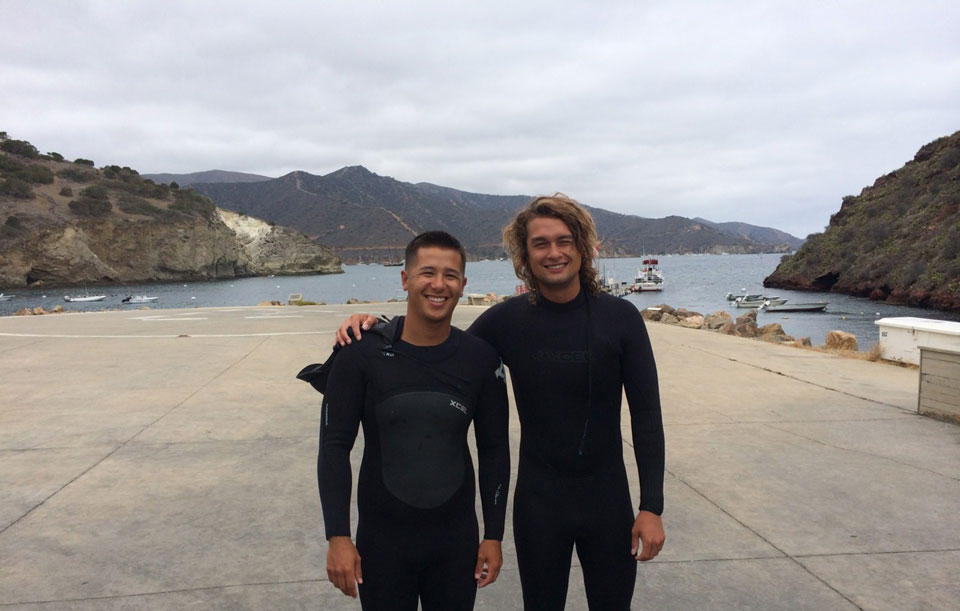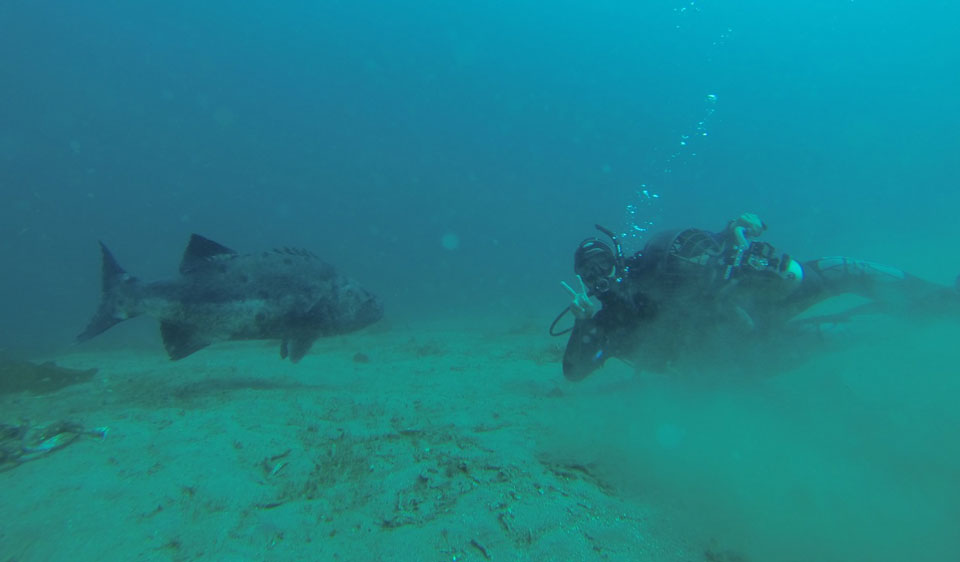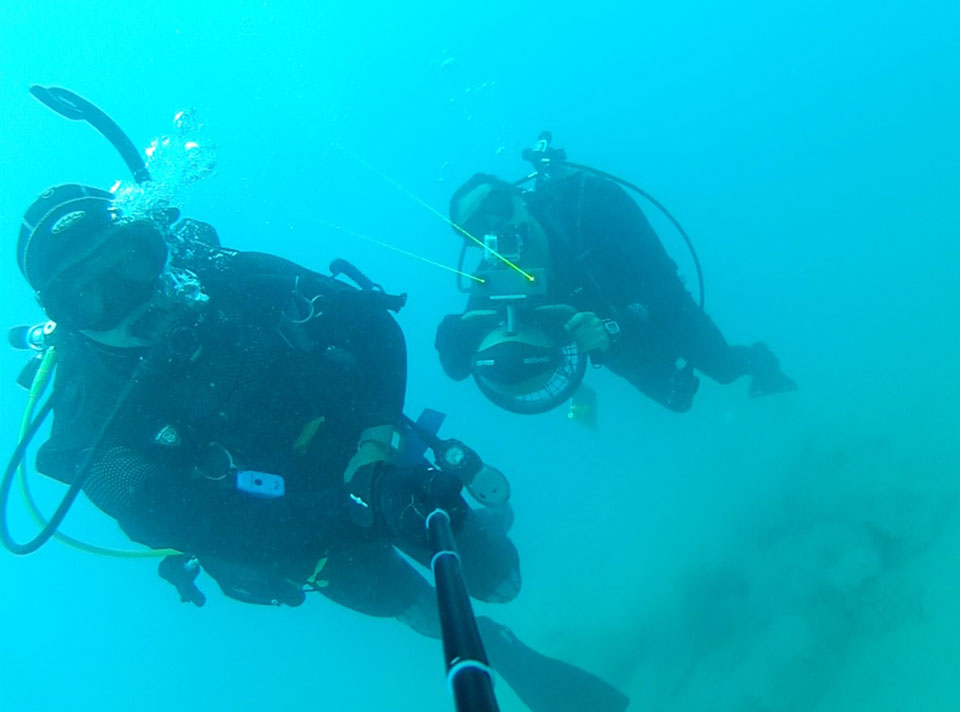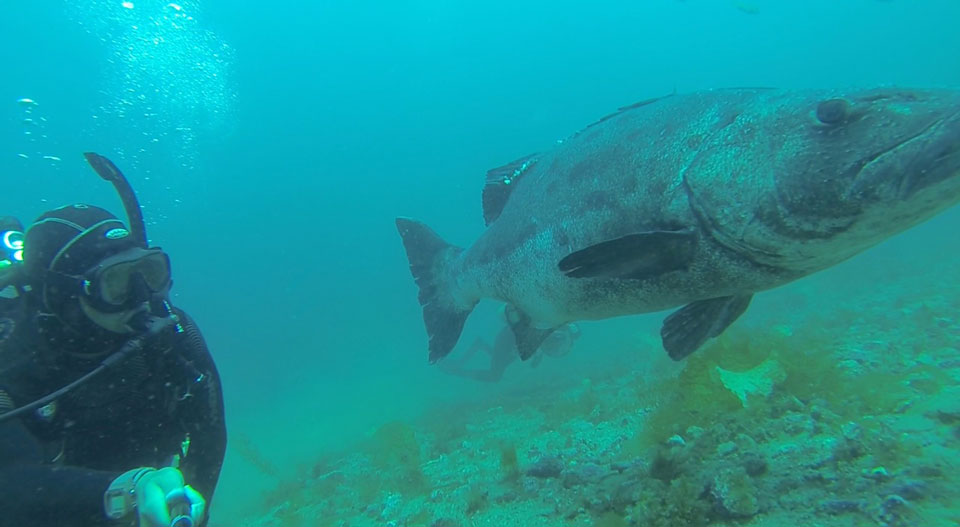CSUN Students Dive Into Marine Research on Catalina Island

(L-R) CSUN marine biology graduate students J.R. Clark and Parker House at work at the Wrigley Marine Science Center on Catalina Island.
Some of California State University, Northridge’s most interesting science research takes place not in Northridge, but 26 miles across the sea — at and around Catalina Island. The marine biology program in the Department of Biology offers undergraduates a fall semester at the island’s Wrigley Marine Science Center, and some graduate students spend much of the summer there engrossed in field work.
The next fall semester cohort kicks off its program Aug. 25. Students will spend 15 weeks on Catalina, based in the dorm and laboratory facilities, studying topics such as marine biology, invertebrate zoology and “ecology of marine fishes.”
“Most of the students call it a life-changing experience,” said Larry Allen, biology department chair, who serves as an instructor and conducts research on the island. “They’re in the water, and they all cite it as a pivotal moment in their development as marine scientists.
“A large percentage of them go on to get Ph.D.s in marine biology. Some go on to become university professors, some work for resource agencies such as U.S. Fish and Wildlife … and a number [become] high school and community college teachers.”
With funding from the offices of the provost and the dean of the College of Science and Mathematics, the biology department supports about 20 students in the marine biology semester. Approximately 200 CSUN students have participated in the program since its inception in 1998. The university offers the special semester every other year. The marine science center is owned and operated by the University of Southern California. The CSU system offers the program in partnership with the Ocean Studies Institute and the Southern California Marine Institute.
This summer, two CSUN graduate students worked with Allen to conduct research on the endangered giant sea bass, which was fished almost to extinction in the 20th century. At up to 600 pounds, the sea bass is California’s largest near-shore fish, Allen said. The CSUN team studied the species’ population density, courtship rituals and spawning.
“We’ve been searching for the elusive ‘king of the kelp forest,’ the giant sea bass,” said marine biology graduate student Parker House, who served as a Wrigley Fellow on Catalina Island this summer. “Although it has been 32 years since these fish have been protected, they are still very rare to see. This is mainly due to them having lifespans close to those of humans, and that they are slow to mature.
“My research is beneficial to understanding how fishing affects kelp forest communities, as well as gaining better insight into the ecology of predators and how they influence food webs,” said House, who earned his bachelor’s in biology at Louisiana State University. “My M.S. at CSUN has helped me gain the tool set I need for my future career in research.”
House and his fellow graduate student, J.R. Clark, used underwater high-definition cameras and underwater listening devices called hydrophones to record the sea bass as the fish called to each other.
“Working out at Wrigley is amazing,” Clark said. “It’s in a beautiful place. The facility has everything we need such as tanks, boats and, most of all, hot showers — which are much needed after a day of diving.
“To execute [the research objectives], I am in the water almost every day, diving three to four times per day and counting, observing and listening to the giants.”
This fall, CSUN marine biology undergraduates will explore timely issues such as climate change, water temperature change and ocean water acidification. The undergraduates wrap up the semester on Catalina Island with a report on their research.
Clark, who earned his bachelor’s degree in marine biology at San Francisco State University, participated in the Catalina semester as an undergraduate as part of the CSU partnership.
“It was an amazing opportunity, allowing me to work on many different projects and getting a good feel for how living the life of a researcher would be,” said Clark, who studied female leopard sharks. “The research project … was pretty difficult, but in the end it was extremely rewarding. This study allowed me to really branch out and figure out my love for research — and steered me on the path to graduate school to study behavior in fishes.”





 experience
experience